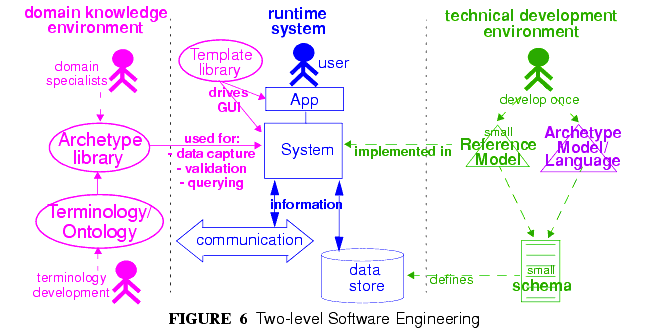I'm a regular Slashdot reader and it's rare to come across a health care related post. So Arguing For Open Electronic Health Records of course caught my eye. I'm sure it was the open standards aspect that attracted them, but I also wanted to point out why the use of software modeling is so important to the development of EHRs.
The Tim Cook post is interesting in several respects.
The first is the reiteration of the importance of the "lack of true interoperability standards" and its affect on adoption of EMR. I've talked about this numerous times.
Another important point is that even though open source licensing may be free, the real costs of implementing any EHR system (i.e. going paperless) are significant.
The importance of understanding and communicating the "semantic context" of patient data is also a key concept.
The goal of the openEHR open-source project is to provide a model and specifications that capture patient data without loss of semantic context. A "two-level modeling" approach is used (from here):

(click on the image to see it at full resolution)
Within this process, IT developers concentrate on generic components such as data management and interoperability, while groups of domain experts work outside the software development process, generating definitions that are used by systems at runtime.
If you've done any work with Microsoft's WPF, this model should look familiar. Separation of responsibilities (designer vs. developer) is one of the fundamental shifts in GUI development that XAML provides. Separating the domain experts from the developers when building a health care IT system is also clearly beneficial.
No matter how good the openEHR model is, it unfortunately has the same adoption problems as many other health care interoperability systems: competing "standards". For example, HL7 V3 Reference Information Model (RIM) and CEN 13606 have the same goals as openEHR.
Developing software systems based on conceptual models of the real world is not new. For example, the OMG Model-driven Architecture (MDA, also see here):
These platform-independent models document the business functionality and behavior of an application separate from the technology-specific code that implements it, insulating the core of the application from technology and its relentless churn cycle while enabling interoperability both within and across platform boundaries.
These types of systems not only provide separation of responsibilities but are also designed to provide cross-platform interoperability and to minimize the cost of technology changes.
The future of inter-operable EHR systems will depend on choosing a common information/behavior model so that the benefits of these development technologies can be realized. The challenge is to make the use of a framework that implements that model something that all stakeholders find advantageous.
Bob,
With so many others, you seem to forget, or at least fail to mention, that a common information/behavior model is not enough to have interoperable systems that do more than just replicating the document-centered approach of paper-based EMRs in an electronic environment. You also need to have a common model of that what the information is about, i.e. of the entities on the side of the patient about which information is stored in information systems. Although the goal of HL7 RIM might be the same as for OpenEHR, it fails seriously in recognizing the distinction that I made. OpenEHR is at least aware of the distinction.
@Werner: Thanks for the feedback. The openEHR concept of “semantic context” is certainly a good one. Every model will need to evolve as more is learned about the nature of the real world it’s trying to represent. One of the hallmarks of a good development framework is its ability to allow these types of changes to be incorporated into the model at minimum cost while maintaining backwards compatibility. This is not an easy task. Software modeling and development technologies have to continue to improve in order to meet these challenges.
Health records – electronic or otherwise – are held within organisational and legal frameworks which define the professional and legal responsibilities of the people and organisations involved in maintaining and using those records.
I’m a GP in England, and paperless – i.e. the only record for my patients is in the EMR (EMIS – if anyone is interested!)
How does the legal framework in the USA influence the design of US EMRs?
[…] last post prompted a comment from Mary Hawking which asked this question: How does the legal framework in the USA influence the […]